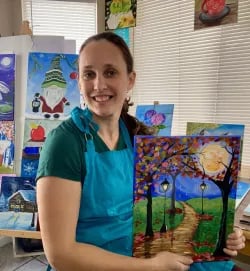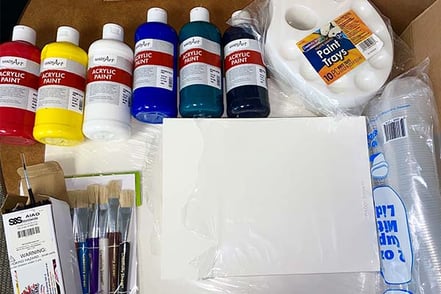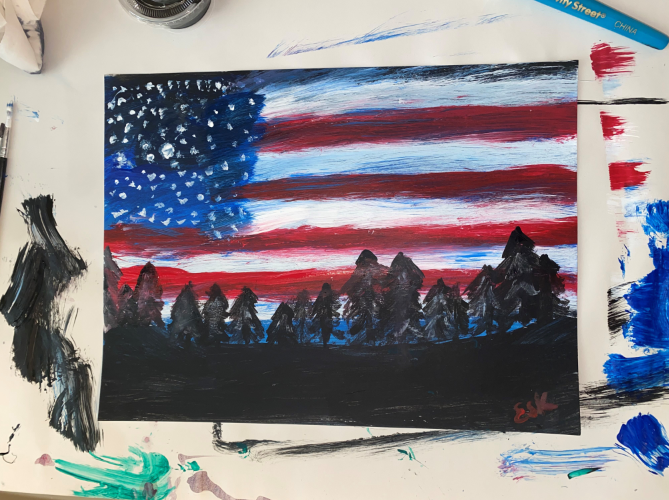Licensed Beds
219
Get in Touch!Call us at 800.999.8590 or Mon - Fri : 9 A.M. - 5 P.M. |
Already a Client?Need Support? |
CASE STUDY
219
2012
Towson, MD
1,455
 The early days of the COVID-19 pandemic brought unprecedented challenges for hospitals across the nation. Like their peers across the country, leaders at the University of Maryland St. Joseph Medical Center immediately began brainstorming ways to improve the patient experience under such unique circumstances.
The early days of the COVID-19 pandemic brought unprecedented challenges for hospitals across the nation. Like their peers across the country, leaders at the University of Maryland St. Joseph Medical Center immediately began brainstorming ways to improve the patient experience under such unique circumstances.
Among the ideas that surfaced, art activities were considered. A review of current literature showed that art and the creation of art could be helpful for reducing anxiety, managing pain, and improving emotional wellbeing. As the hospital did not have a licensed art therapist to guide an art program as an alternative therapy, it was decided that a recreational art program for distraction and enjoyment would be the best approach.
Patient Experience Program Manager Victoria Chahanovich, CPXP, and her team took ownership of the initiative, with Project Management Intern Taha Nasir jumping in to help. Mr. Nasir was passionate about the idea of a painting program for patients. A friend of his family had served as an art teacher for children in underprivileged communities and had shared anecdotes about the powerful impact of art on the students. Recalling those stories, Mr. Nasir felt confident that hospitalized patients could experience many of the same benefits from art activities.
The team began by evaluating various mediums of art, considering the level of difficulty, time, and resources needed to engage patients. Ultimately, they decided on painting as a feasible intervention. “We envisioned something like Bob Ross painting programs on TV,” explained Ms. Chahanovich. “We could provide the materials and let the patients follow a video to create their own painting.” They browsed the web for tutorial videos and found content produced by artists that would be appropriate for their patients.
The team then reached out to Michelle Dodge, their Client Outcomes Manager at Avidex to explore using their Tigr interactive system to broadcast the videos. Ms. Dodge walked the team through system features that could be leveraged to support the project, and contacted the artists on behalf of the hospital to invite their participation. Ms. Dodge also identified additional artists with tutorial content online that aligned with the intent of the initiative. After the initial lineup of tutorial videos was decided by the team, Ms. Dodge coordinated the next steps with the content owners. All of the artists were enthusiastic about participating in the project and graciously granted permission to St. Joseph Medical Center to use the content, with some even providing special versions of their tutorials adapted for an inpatient audience. One artist who provided content shared that “I have suffered depression/anxiety myself and art continues to help. I hope it brings joy to patients, the way it does for me.” Ms. Dodge uploaded the videos to the Tigr system, making them available for broadcast to in-room televisions throughout the hospital.
Artist Tracie Kiernan, the owner of stepbysteppainting.net, was one of the content producers invited to participate in the initiative. She was excited to create and share a collection of videos for this program.
Ms. Kiernan knew from personal experience how meaningful art activities could be for patients, as she had recently shared painting lessons with a family member that had been terminally ill. “It brought him so much joy,” states Ms. Kiernan. “He said it was a wonderful distraction from everything going on. He painted a lot during his last few months, and his paintings now bring comfort and joy to his family.” Another artist who provided content shared that “I have suffered depression/anxiety myself and art continues to help. I hope it brings joy to patients, the way it does for me.”

The content contributors made helpful recommendations for the painting supplies needed. With an intial investment of $100, Ms. Chahanovich’s team purchased art supplies including paints, brushes, palettes, and canvases. They packaged them into individual kits, labeling them with instructions for accessing the appropriate video tutorial on-demand through the Tigr system. The kits were stocked on a rolling cart, which became known as the HeART cart.
 To kick off the initiative, Mr. Nasir began making daily visits on the Cardiac Surgery floor, selected as the pilot location for its larger patient population and longer length of stay. Mr. Nasir spoke with unit staff each day to identify patients who were appropriate for participating in a painting activity. He would round on those patients in the morning to invite them to participate, then return later in the day with the HeART cart. Once each patient had their materials and workspace ready for painting, a tutorial video would play at a scheduled time through the Tigr system. Mr. Nasir would round again upon completion of the video for cleanup and collection of materials, followed by a short interview with each patient about the experience.
To kick off the initiative, Mr. Nasir began making daily visits on the Cardiac Surgery floor, selected as the pilot location for its larger patient population and longer length of stay. Mr. Nasir spoke with unit staff each day to identify patients who were appropriate for participating in a painting activity. He would round on those patients in the morning to invite them to participate, then return later in the day with the HeART cart. Once each patient had their materials and workspace ready for painting, a tutorial video would play at a scheduled time through the Tigr system. Mr. Nasir would round again upon completion of the video for cleanup and collection of materials, followed by a short interview with each patient about the experience.
The positive impact of the painting activity was observed immediately. Feedback from patients was overwhelmingly favorable, with growing enthusiasm from staff to match. “It didn’t take long before nurses on the unit would get excited to see him approaching with the HeART cart and would have referrals ready for him,” says Ms. Chahanovich.
Ellen Sheridan, MS, MEd, RN, Program Coordinator for the LAUNCH Residency, Mentorship and Clinical Nurse Internship at St. Joseph’s Medical Center, was pleased to see how warmly nurses embraced the initiative. “Volunteers did all the work, so there was nothing extra asked of nurses,” she explains. “When they saw how much of a difference it made for their patients, it was a no brainer.”
A total of 50 patients were interviewed in the first phase of the pilot. The 100% positive response across all measures was valuable benchmarking data, but the most compelling outcomes of the initiative came to light in patient feedback about the experience.
“The raw data provided a great indication to move forward with this project,” states Ms. Chahanovich. “However, the actual narratives from the patients were the reason we were able to gain so much support from leadership when we discussed expanding this program.”
| Post Activity Survey Question | Yes | No |
|---|---|---|
Would You Participate Again? |
50 |
0 |
Would You Recommend This Program to Other Patients? |
50 |
0 |
Has This Improved Your Experience At St. Joe's? |
50 |
0 |
Based on the success of the pilot, the HeART Program was implemented throughout the rest of the hospital’s inpatient units. As the program expanded throughout the hospital, the team recognized that offering patients more choices could serve to increase participation and satisfaction, so they shifted from scheduling specific tutorial videos to offer a choice of painting projects on demand. Patients were presented with options such as sunsets, hot air balloons, natural landscapes, and the American flag. Kits were prepared with the materials needed to create the paintings and instructions for accessing the tutorial video, which volunteers would assist patients with initiating on-demand. In addition, more help was needed to sustain the program as Mr. Nasir was completing his internship and preparing to return to school to finish his degree, so volunteers were recruited and trained on rounding with the HeART cart to engage patients in painting activities.
The team continued to assess the impact of the program through patient surveys and video viewing data from the Tigr system. While on-demand views of the art tutorial videos increased after the hospital-wide rollout, utilization was not the key measure of success. “We understood that even if only 10% of patients wanted to participate, it would still make a difference to that small group,” states Ms. Chahanovich.
More lessons unfolded as the program reached patients in other units. The team discovered a few common barriers to participation in art activities and came up with creative solutions to address them.
Early in the rollout, lower engagement was noted among patients who were waiting to be pulled from the room for procedures or tests, or who anticipated a shorter length of stay. In response, the team increased the flexibility of the program by adding colored pencils to allow participants to decorate a card for a loved one. Other patients would decline because of their emotional state or fatigue but still gained an awareness of the program so they could request to participate when they felt better.
.png?width=441&height=353&name=Avidex%20Collage%20of%20Painting%20with%20Patients%20Artwork%20(1).png) As demand for the program grew, St. Joseph’s Medical Center applied for a grant from the Beryl Foundation and received funding for more art supplies and enhancements of the HeART Cart. Ms. Chahanovich and her team revised the scripting to present the painting activities in a clear manner, emphasizing positive feedback from patients who had previously participated. They trained additional volunteers, who also began showing paintings completed by other patients as examples of how a finished work might look. Seeing the paintings served to create excitement among patients and for many, gave them the boost of confidence that they too could be artists too.
As demand for the program grew, St. Joseph’s Medical Center applied for a grant from the Beryl Foundation and received funding for more art supplies and enhancements of the HeART Cart. Ms. Chahanovich and her team revised the scripting to present the painting activities in a clear manner, emphasizing positive feedback from patients who had previously participated. They trained additional volunteers, who also began showing paintings completed by other patients as examples of how a finished work might look. Seeing the paintings served to create excitement among patients and for many, gave them the boost of confidence that they too could be artists too.
More than three years after COVID-19 arrived in the United States, hospital operations have largely returned to normal following the end of the public health emergency declaration. Still, many of the innovations and creative approaches developed to support positive patient experiences during the pandemic have remained in place. The Painting with Patients program at St. Joseph’s Medical Center is one such program that endures beyond the lifting of pandemic restrictions, with continued support from the hospital’s Client Outcomes Manager at Avidex. “She’s been such a great partner in guiding us toward where we needed to go with this project,” says Ms. Sheridan.
“As we continue sharing art activities with patients, we discover new ways to measure success,” states Ms. Chahanovich. “For instance, we tell patients that they can keep their finished paintings, or if they’d prefer, they can donate them back to the hospital to be displayed in common areas. Over time, more and more patients have opted to take their paintings home. One of the most profound statements we hear from patients is that painting ‘made me forget that I was in the hospital.’ But when a painting goes home with a patient, it tells me they created a positive memory during their time in our care. We gave them a patient experience they don’t want to forget.”
An artist's rendtion of the flag next to a patient's artwork of the same image.


Avidex is uniquely suited to support your internal resources through comprehensive services, including Client Success Management with our Clinical Outcomes Team.

Connect with one of our audiovisual experts and start creating an unforgettable AV experience today!
Get In TouchCall us at 800.798.0330 or
complete the form below and
we'll respond in 1 business day or less.